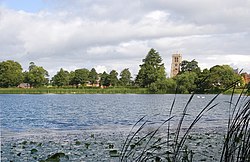Hanmer
| Hanmer | |
| Flintshire | |
|---|---|
 Hanmer Mere | |
| Location | |
| Grid reference: | SJ455396 |
| Location: | 52°57’5"N, 2°48’45"W |
| Data | |
| Population: | 726 (2001) |
| Post town: | Whitchurch |
| Postcode: | SY13 |
| Local Government | |
| Council: | Wrexham |
| Parliamentary constituency: |
Clwyd South |
Hanmer is a village in the Maelor Saesneg part of Flintshire. At the 2001 the population of the Hanmer community area, which includes Hanmer village itself, Horseman's Green and Arowry along with a number of small hamlets, was recorded at 726.
The village of Hanmer lies at the northern end of Hanmer Mere, a fair lake spreading out from the village to the woods beyond. It is part of the 'Shropshire lake district' of meres which was formed during the last Ice Age
The name of the village comes from its lake. The name is thought to have either originally been "Handmere",[1] or "Hagenamere", perhaps taking its name from a Mercian lord.[2]
Parish church
The parish church is St Chad's, within the Diocese of St Asaph in the Church in Wales.
Around 1380-1383, Owain Glyndŵr was married here to Margaret Hanmer, the daughter of the local magnate, Sir David Hanmer, who was a Justice of the King’s Bench.
The oldest recorded reference to a church in Hanmer dates from 1110, though this building was destroyed in 1463 during the Wars of the Roses.[1] It was rebuilt in 1490, destroyed again by fire in 1889 along with many irreplaceable architectural features, and rebuilt between 1892 and 1936, when the chancel was finally reconstructed.
St Chad's features in "Bad Blood", the award winning and best selling autobiography of Lorna Sage, who recorded her childhood in Hanmer Vicarage during the post-war years
History
Hanmer and its lands became the estate of (and gave its name to) the prominent Hanmer family, who were descended from Sir Thomas de Macclesfield, an officer of Edward I.[3] Sir Thomas settled in Maelor Saesneg and his family consolidated their possessions in the area through a series of marriages to heiresses of important Welsh families.
Humphrey Hanmer left Hanmer in 1630 for the American colonies; he settled in what is now West Virginia and the Hamner (sic) family there is descended from him.
In 1643, during the Civil War, Roundheads from Nantwich raided the village and stabled their horses in the church. The horses were placed in Fenn’s Chapel where the organ now stands. On 23 June that year, a large body of Parliamentarian horse and dragoons were “cut to pieces” at the side of Hanmer mere, by Royalists.
Important buildings
- Saint Chad's Church
- The Hanmer Hotel
- Magpie Cottage
Outside links
References
- ↑ 1.0 1.1 Information on Hanmer from GENUKI
- ↑ Hanmer, BBC North East Wales]
- ↑ Hanmer family, Dictionary of Welsh Biography, National Library of Wales
